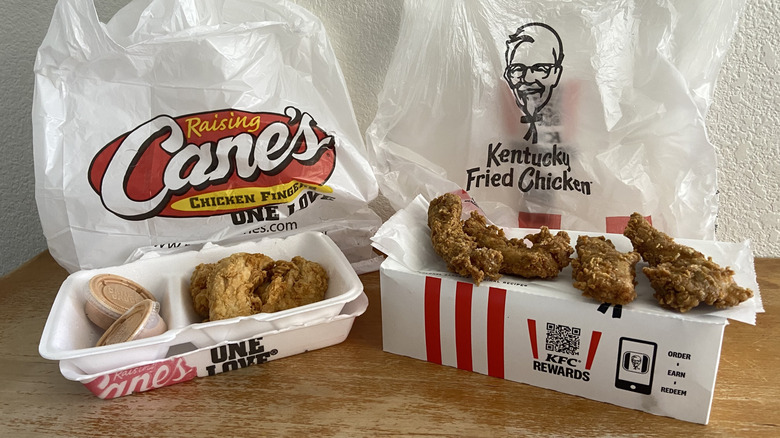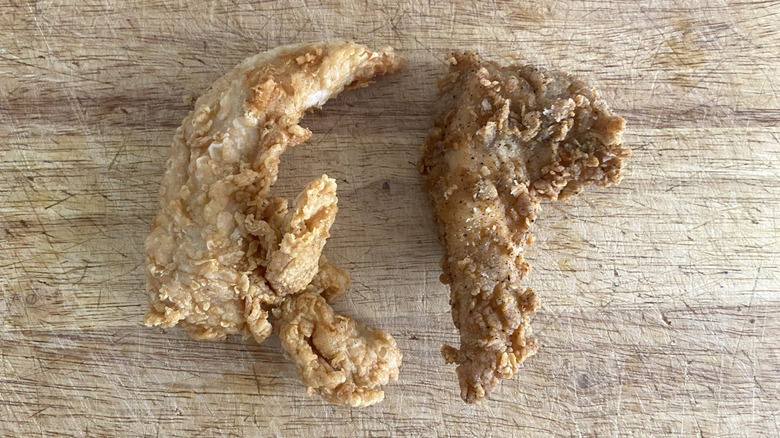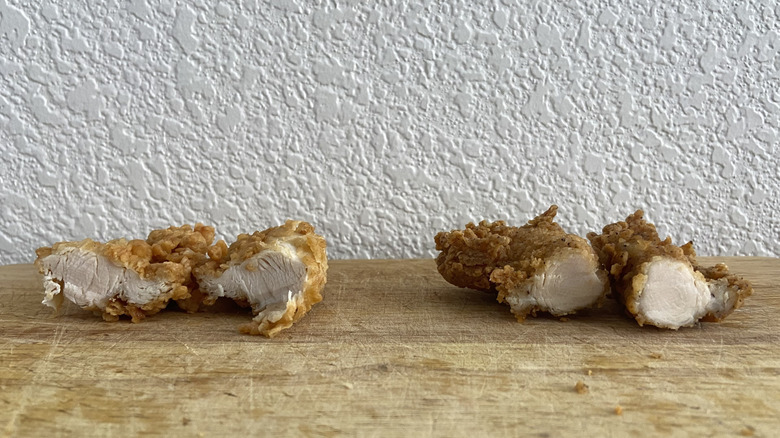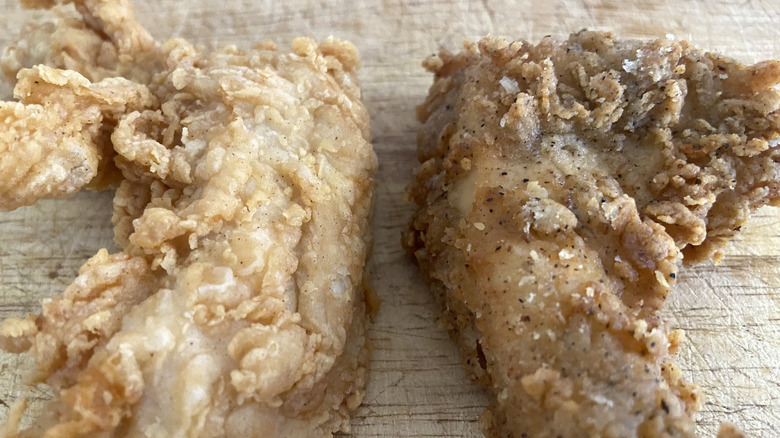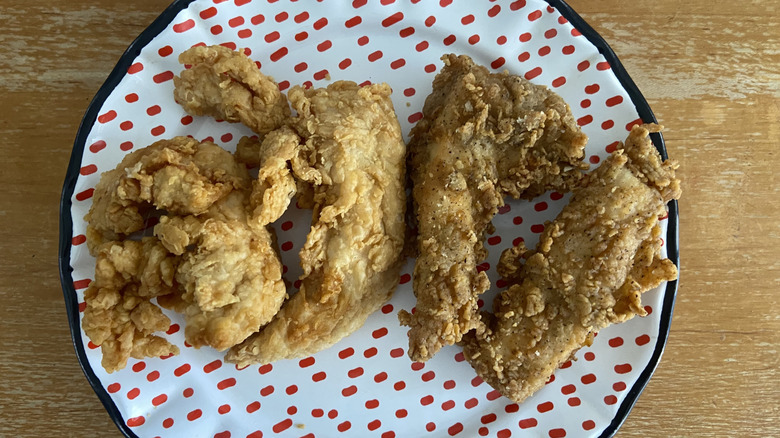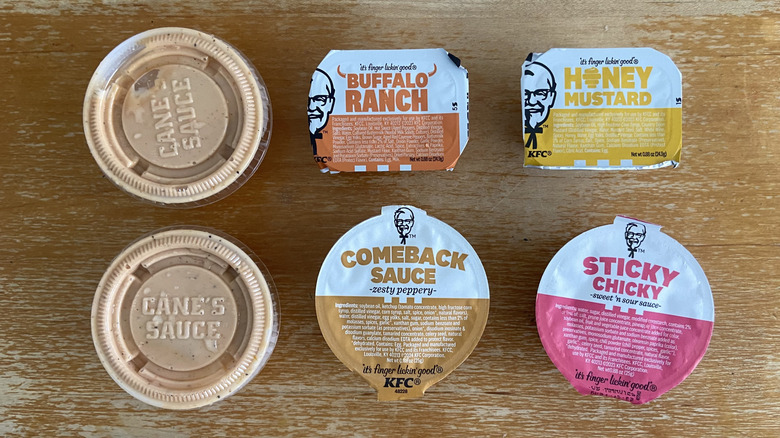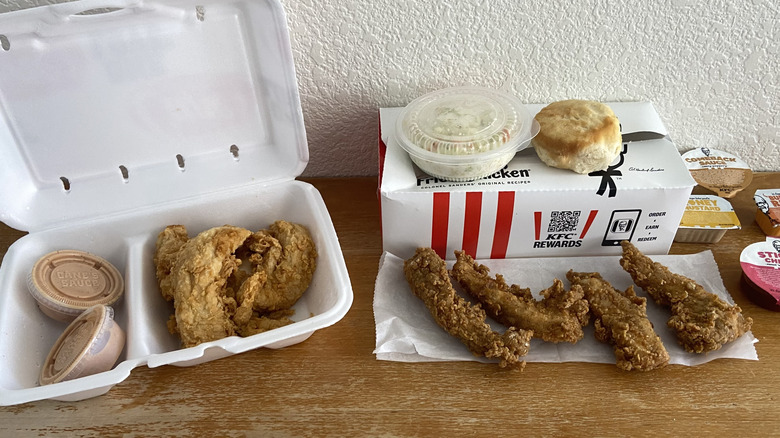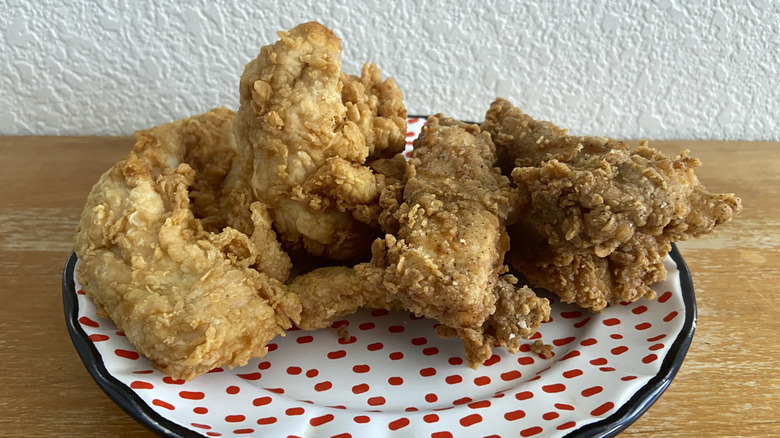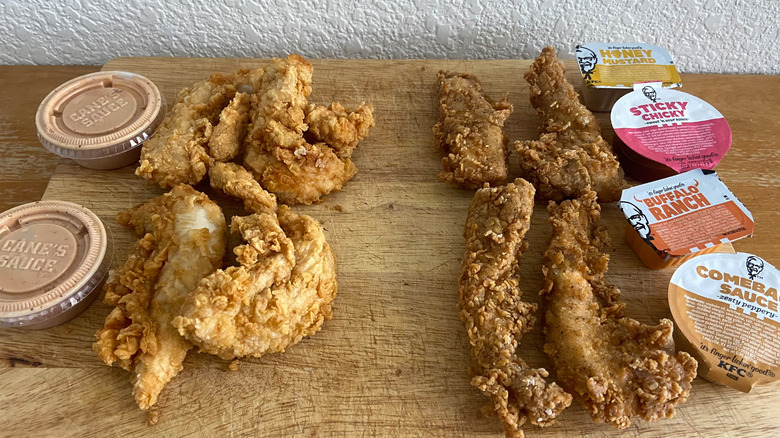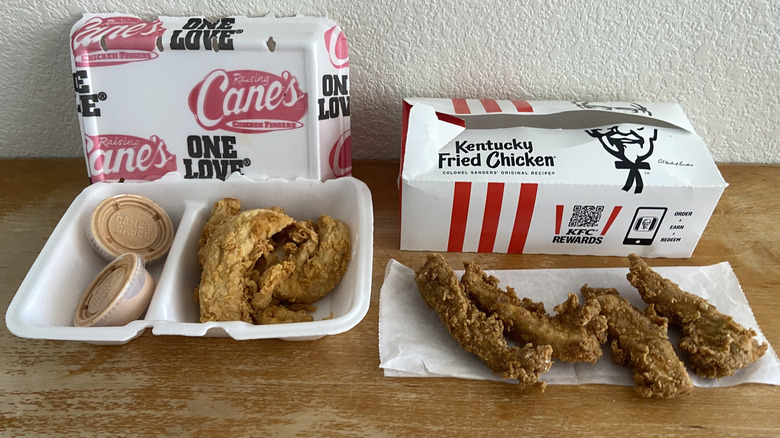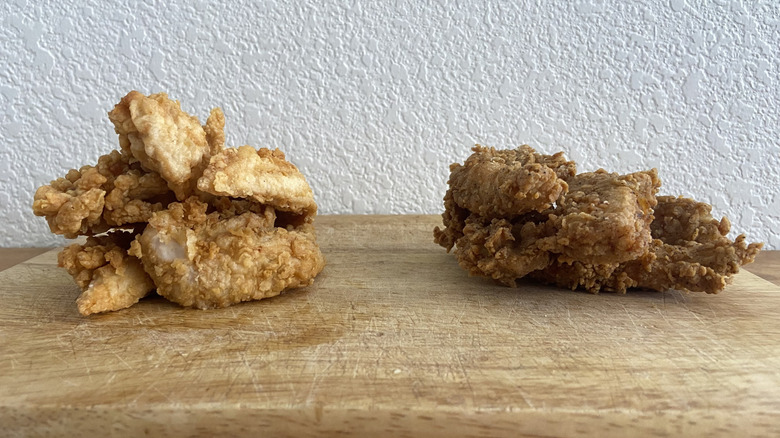KFC Vs Raising Cane's: Which Chain Makes The Best Chicken Tenders?
In October 2024, KFC revamped its proprietary chicken tender recipe, replacing Extra Crispy Tenders with Original Recipe Tenders. What makes the newer item distinct is its incorporation of the same signature 11 herbs and spices that flavor the breading on KFC's classic fried chicken. Any fast food chicken tender, of course, must reckon with the behemoth that is Raising Cane's. When KFC introduced its new tenders, customers' passion for the famously delicious Raising Cane's chicken was already fueling considerable growth for the Raising Cane's brand. Meanwhile, KFC struggled in 2024, prompting corporate restructuring and rebranding initiatives heading into 2025.
When I compared Popeyes tenders to Raising Cane's tenders, the latter chain won pretty handily. Simply put, Raising Cane's maintains a streamlined menu that helps ensure a high level of quality, and it's hard for a more comprehensive chain like Popeyes to compete. With that said, KFC's Original Recipe Tenders were pretty explicitly crafted to rival competitors like — and perhaps most importantly — Raising Cane's. With that in mind, I picked up tenders from both KFC and Raising Cane's and tried them side-by-side. Here's how they fared against one another in nine categories before my pick for the chain that makes the best chicken tenders overall.
Whose tenders look better?
Both Raising Cane's and KFC know how to make a good-looking chicken tender. Where Raising Cane's tenders excel most in the looks department is their deep crags and abundance of breading. The former quality suggests an amply crispy coating, whereas the latter — each tender I picked up from Cane's on this trip had some portions of pure breading attached to the chicken — provides the opportunity for some extra crunchy chicken bites or even bites of pure crunch. Combined with an aesthetically pleasing golden brown color, tenders from Cane's look like they're going to taste great.
Meanwhile, the KFC tenders are darker in color, suggesting a more indulgent, deep-fried character. While they're not as craggy, they still exhibit a visible crispiness. Plus, my KFC tenders were more uniformly breaded, whereas bits of breading flaked off of a couple of my Cane's tenders. That's all accentuated by visible black pepper seasoning, indicating a flavor absent from the appearance of tenders from Cane's. While both styles of chicken tender look delicious, I just slightly prefer the appearance of KFC's. Simply put, if I had to pick one or the other with no knowledge of its origin, I would opt for the KFC tender because its deep-fried and seasoned appearance suggests a bolder flavor.
How does the quality of each chain's chicken stack up?
Biting into a piece of pure Raising Cane's chicken with no breading attached drives home the fact that high quality chicken is key to what makes the chain's tenders so good. Flavor-wise, the Raising Cane's chicken is umami-forward from what I assume to be marination before breading. Texturally, the chicken pulls apart like a freshly cooked chicken breast. And, despite the fact that it's intended for dipping, the chicken maintains plenty of moisture.
Comparing cross-sections of each tender side-by-side, it's clear that KFC's chicken isn't of the same caliber — it's drier and firmer, appearing like a solid mass. It's worth noting that chicken tenders and chicken fingers aren't the same thing due to tenders requiring the use of tenderloin meat. KFC refers to its chicken strips as tenders, indicating that the chain uses that specialized cut of chicken. KFC falls short in this category, then, not because of the type of meat it uses but simply because it serves chicken that's of a lower quality than Raising Cane's.
How are the tenders seasoned?
Ask a critic of the otherwise popular Raising Cane's chicken finger chain what they don't like about its chicken and they will most likely mention a lack of seasoning. While it's true that plain Raising Cane's tenders don't necessarily taste bold, they're far from bland. Rather, what comes across is a salty buttermilk character. Thanks to high-quality chicken and, of course, the sauce is intended to be dipped in, that flavor works. That said, if the chicken were lower quality or served without Cane's Sauce, the subtlety of Raising Cane's seasoning could become a detriment.
While I don't think the Raising Cane's approach to seasoning is a bad thing, I also happened to really enjoy the seasoning on my KFC tenders. That's no accident — the point of KFC's Original Tenders rebrand is that these new tenders are seasoned with the rich, salty 11 herbs and spices that made the chain famous. As intended, each of my Original Tenders tasted like a boneless version of the chicken that built the iconic KFC chain. So, even if I think a plain tender from Raising Cane's is good, I liked the seasoning on my plain KFC tenders even better.
Which chain uses better breading?
Judging each style of chicken tender's appearance largely involved analyzing its breading, due, of course, to the fact that breading is pretty much all that's visible on a tender's exterior. For the most part, the look of each type of breading was accurate to its character, albeit with some noteworthy complications.
First off, the quantity of breading on my Raising Cane's tenders was generous, resulting in some especially satisfying bites with extra crisp. Unfortunately, a couple of my Raising Cane's bites were brought down by soggy breading. While that's not something I typically encounter at Raising Cane's, it impacted this experience all the same. Meanwhile, KFC's breading — while less visibly craggy — is even crunchier than its competition. As is essentially the case with the food from Raising Cane's on the whole, its breading tastes cleaner compared to what seems like a more processed breading from KFC. That said, I found the added crunch factor more important and enjoyed KFC's breading more than the cleaner coating on my tenders from Raising Cane's.
How do their sizes compare?
To figure out which chain serves larger chicken tenders, I did my best to measure each tender with a ruler. While none of my tenders were shaped such that mere length and width measurements could accurately reflect their total volume, I used that data to approximate average sizes and found that one chain does indeed offer larger tenders.
Height, notably, was a non-factor because my tenders from Raising Cane's and KFC all averaged about the same in that category. Length too ultimately became negligible when I determined that all of my tenders were about 4 inches long. For what it's worth, three of my four KFC tenders were practically uniform in length, whereas my Cane's tenders varied a bit more in that department. Finally, my Raising Cane's tenders averaged a width of 1.5 inches, whereas my KFC tenders were 1 inch wide on average. So, even if KFC sizes its tenders more consistently, Raising Cane's just barely provided me with bigger chicken tenders on the whole.
Whose sauces are better?
Sauce variety is one of the foremost ways an order of chicken tenders from Raising Cane's differs from an order of tenders at KFC. Raising Cane's, of course, offers just Cane's Sauce for tenders as well as ketchup for fries, which can technically flavor its tenders, too. There's also a honey mustard sauce on the Raising Cane's secret menu, but I admittedly did not know about this option before my visit. Simply put, Cane's Sauce is awesome. Its flavor balances spice, fat, and umami richness with a hard-to-place X factor — if that X factor were easy to define, every chicken chain would offer its own take on the recipe.
In fact, KFC made an attempt anyway with its Comeback Sauce, introduced alongside the Original Tenders. However, it's a pale imitation, merely combining a pronounced tanginess with a strong black pepper flavor. That said, there are plenty of additional kinds of sauces on the KFC menu, three of which I tried. Of them, Sticky Chicky Sauce was my least favorite. It effectively approximates an orange chicken coating but with less orange flavor. It wasn't bad but felt out of place on a KFC tender. Next up was Honey Mustard, which tasted surprisingly clean for something from KFC and added a satisfying wasabi-esque bite. My favorite was Buffalo Ranch, which tasted like equal parts buttermilk ranch and spicy buffalo. No KFC sauce managed to approach Cane's Sauce's spot on the dipping sauce throne.
Which tenders are more customizable?
While the menu at Raising Cane's is simple, it's easier than it might seem at first glance to customize a chicken tender order. By default, tenders are packaged in combo boxes in quantities of three, four, or six, with fries, slaw, Texas toast, sauce, and a drink. Also available are a two-tender kids meal and a combo with a sandwich that uses three tenders as its protein. With that said, tenders — and it's worth clarifying here that they're technically referred to as chicken fingers — and sauces can both be ordered à la carte, too. I took advantage of this option and ordered four tenders and two sauces for this exercise.
Customization at KFC, meanwhile, works a bit differently. Tenders can be ordered à la carte, but each single tender is packaged with a sauce by default. Also offered are 8-piece, 12-piece, and 16-piece tender boxes. Various combos, meanwhile, similarly include a drink, a biscuit, choice of sauce, and a choice of side or sides. While a lot of the same permutations of tenders and accompaniments are offered at each chain, a larger selection of sauces, sides, and combo types wins this category for KFC.
How do they compare nutritionally?
One chicken finger from Raising Cane's totals 130 calories, 6 grams of fat, 1 gram of which is saturated fat, 40 milligrams of cholesterol, 190 milligrams of sodium, 5 grams of carbs, 1 gram of fiber, and 13 grams of protein. Meanwhile, a single KFC chicken tender adds up to 170 calories, 6 grams of fat, 0.5 gram of which is saturated fat, 30 milligrams of cholesterol, 400 milligrams of sodium, 20 grams of carbs, 1 gram of fiber, and 11 grams of protein.
The sole nutritional category in which KFC tenders come out non-negligibly ahead versus Raising Cane's is cholesterol. Technically each tender contains less saturated fat, too, but the quantities are small enough that they hardly matter. Rather, massively higher amounts of sodium and carbs in each KFC tender are what result in a less healthful product. Raising Cane's then is the nutritionally preferable option.
Whose tenders are a better value?
Since KFC and at least some Raising Cane's locations are franchised, prices can differ from restaurant to restaurant. With that said, an individual tender at my local Raising Cane's costs $1.81 and a single sauce is $0.39. Three-tender, four-tender, and six-tender combos are $9.89, $11.59, and $16.59, respectively. From my closest KFC, a single tender with sauce costs $2.49. Three-tender, four-tender, and five-tender combos are $9.49, $11.49, and $12.99 each. Plus, 8-piece, 12-piece, and 16-piece tender boxes are $18.49, $25.99, and $32.99 each. There are even a couple of other larger combos on the menu, too, but those are less relevant to this category due to their abundance of sides.
Immediately of note is the fact that KFC's combos cost a little less than their counterparts at Raising Cane's. That said, while anecdotal, I find that the quantities of sides make up for the slight differences in price. Meanwhile, individual tenders are considerably less expensive, especially taking into account that each tender need not come with its own sauce as is the case at KFC. Even an order of 16 individual tenders and eight sauces from Cane's totals $32.08, just slightly cheaper than the box that should save customers the most money at KFC. So, even if its combos are a little pricier, altogether cheaper individual tenders make for a just slightly better value at Raising Cane's.
The best chicken tenders are from Raising Cane's
Raising Cane's won five of my nine categories, securing a slight majority over KFC. Complicating matters is the fact that my favorite bite of the meal I arranged for this competition was a KFC tender dipped in Cane's Sauce. Nevertheless, I stand by the numbers — Raising Cane's makes superior chicken tenders, but to KFC's credit, its tenders put up a fight.
What affirmed my belief in my findings is the fact that, hypothetically having to choose between an order of tenders from either chain, I would prefer tenders from Cane's. Working backwards from this gut feeling, I realized that, even if the superior seasoning and breading on KFC chicken tenders results in something that tastes a little better on its own, tenders aren't intended to be consumed plain. Higher-quality, healthier chicken combined with that all-important Cane's Sauce results in an overall better product at Raising Cane's. With such close competition and an arguably tastier base tender at KFC, a change as simple as introducing a truly killer sauce could nudge KFC across the finish line in a future competition. But, based on each chain's offerings at the time of my visit, Raising Cane's secured the win.
Methodology
From my nearest KFC in Henderson, Nevada, just outside of Las Vegas, I picked up a four-tender combo with Comeback Sauce and Sticky Chicky Sauce, in addition to side orders of Honey Mustard and Buffalo Ranch sauces. Then, I drove to my nearest Raising Cane's and ordered four chicken fingers and two Cane's Sauces. Neither chain had any indication my orders were not for an everyday lunch but for the sake of an article.
Once I brought everything home, I consumed it all in the same sitting. First, I methodically ate one dissected tender from each chain, allowing me to assess categories like chicken quality, seasoning, and breading. Then I started eating my tenders close to how I would during a normal meal, albeit while making sure to take notes on how I felt about each style of tender and each sauce. Finally, just for the sake of the most comprehensive evaluation possible, I cross-pollinated my items from each chain, dipping KFC tenders into Cane's Sauce and vice versa. My opinions are based solely on this single meal, outside of a couple instances in which I felt it helpful to invoke past experiences, each of which is explicitly noted.
